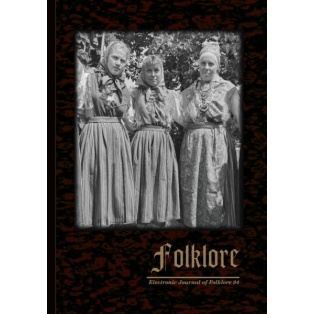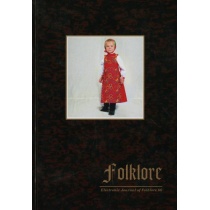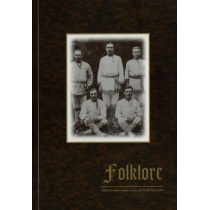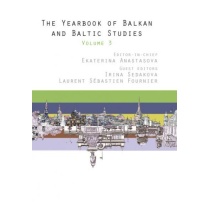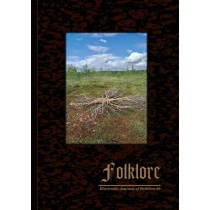Folklore 94
This special issue of Folklore: Electronic Journal of Folklore gathers research articles that are based and elaborate on the presentations given at the conference under the theme “Voice, Connection and Message in Traditional Singing”.
Jelena Jovanovič explores the transcendable ritual function in Serbian traditional songs employed in current singing practices. The article documents an experiment intended to arrange a performance of a selection of multipart repertoires of various peoples in Europe, which was unfortunately altered by the COVID-19 pandemic lockdown conditions.
Austė Nakienė and Rūta Žarskienė have studied the singing practice and the preferred traditional repertoires in the first-generation diaspora communities of Lithuanians in the United States, which were recorded by Jonas Balys, a seminal folklorist of the time. This historiographical review traces the documentation of traditional songs in which the image of the homeland left behind connects to memories of the practice of singing traditional songs.
Janika Oras examines the complexities of a colonial subject position by introducing a talented professional stage performer of folklore from the mid-twentieth-century Estonia, Laine Mesikäpp, who practiced traditional singing styles and repertoires. The article focuses on her creative voice and messages, which were compromising, censored, and self-censored, but also resistant, constantly testing the limits.
Savannah-Rivka Powell investigates the encoded Ainu identity and its bonds to the transnational Indigeneity movement, which the Ainu folk music revival promotes. The analysis traces the fusion of historical sources with global popular music styles, which creates a positive hybridity that carries the potential to build connections among the modern urban Ainu.
Liina Saarlo highlights the role of an individual, be it a singer as a performer or the counterpart represented by a documenting folklore collector. The author questions the latter’s aesthetic judgements on the performative qualities as well as the overall scarcity of meta-data concerning the performance context.
Hanna Karhu builds her critical study on the usage of archival materials when presenting Finnish rhymed folk songs that have fed into literary works, which became particularly popular in early-twentieth-century theatrical performances. She illuminates the process of national identity construction in Finland where creative writers of the new literary culture elaborated traditional songs into modern poetry through selection and recontextualisation.
Kati Kallio, Mari Väina, Maciej Janicki, and Eetu Mäkelä introduce explorations of the similarities detectable between texts found in the Estonian language ERAB corpus and Karelian-Ingrian-Finnish language SKVR and JR corpora. Based on their research on various levels – song types, verse types, motifs, and formulae – the authors conclude that there is no single computational method or toolbox suitable for tracking all the aspects of similarities and variabilities.
Olha Petrovych, Inna Zavalniuk, and Valentyna Bohatko study in their analysis the semantic usage of vocative expressions to address or invoke someone, and to serve as guides for introducing substantive and emotional elements, distinguishable in the folk song corpus from the Podillia region in Ukraine.
Taive Särg and Kaarel Veskis address the concepts denoting singer or singing, which have been comparatively extracted from an archival corpus of Estonian media texts from the 1890s, and from the corpus of song lyrics / poetic texts at the Estonian Folklore Archives. The results highlight the verbal quality of the vernacular concept in traditional poetry, while also demonstrating the potential of corpus linguistics.
Folklore: EJF is a peer-reviewed open-access academic journal published since 1996, and the current issue is available online at https://www.folklore.ee/folklore/vol94/.
Jelena Jovanovič explores the transcendable ritual function in Serbian traditional songs employed in current singing practices. The article documents an experiment intended to arrange a performance of a selection of multipart repertoires of various peoples in Europe, which was unfortunately altered by the COVID-19 pandemic lockdown conditions.
Austė Nakienė and Rūta Žarskienė have studied the singing practice and the preferred traditional repertoires in the first-generation diaspora communities of Lithuanians in the United States, which were recorded by Jonas Balys, a seminal folklorist of the time. This historiographical review traces the documentation of traditional songs in which the image of the homeland left behind connects to memories of the practice of singing traditional songs.
Janika Oras examines the complexities of a colonial subject position by introducing a talented professional stage performer of folklore from the mid-twentieth-century Estonia, Laine Mesikäpp, who practiced traditional singing styles and repertoires. The article focuses on her creative voice and messages, which were compromising, censored, and self-censored, but also resistant, constantly testing the limits.
Savannah-Rivka Powell investigates the encoded Ainu identity and its bonds to the transnational Indigeneity movement, which the Ainu folk music revival promotes. The analysis traces the fusion of historical sources with global popular music styles, which creates a positive hybridity that carries the potential to build connections among the modern urban Ainu.
Liina Saarlo highlights the role of an individual, be it a singer as a performer or the counterpart represented by a documenting folklore collector. The author questions the latter’s aesthetic judgements on the performative qualities as well as the overall scarcity of meta-data concerning the performance context.
Hanna Karhu builds her critical study on the usage of archival materials when presenting Finnish rhymed folk songs that have fed into literary works, which became particularly popular in early-twentieth-century theatrical performances. She illuminates the process of national identity construction in Finland where creative writers of the new literary culture elaborated traditional songs into modern poetry through selection and recontextualisation.
Kati Kallio, Mari Väina, Maciej Janicki, and Eetu Mäkelä introduce explorations of the similarities detectable between texts found in the Estonian language ERAB corpus and Karelian-Ingrian-Finnish language SKVR and JR corpora. Based on their research on various levels – song types, verse types, motifs, and formulae – the authors conclude that there is no single computational method or toolbox suitable for tracking all the aspects of similarities and variabilities.
Olha Petrovych, Inna Zavalniuk, and Valentyna Bohatko study in their analysis the semantic usage of vocative expressions to address or invoke someone, and to serve as guides for introducing substantive and emotional elements, distinguishable in the folk song corpus from the Podillia region in Ukraine.
Taive Särg and Kaarel Veskis address the concepts denoting singer or singing, which have been comparatively extracted from an archival corpus of Estonian media texts from the 1890s, and from the corpus of song lyrics / poetic texts at the Estonian Folklore Archives. The results highlight the verbal quality of the vernacular concept in traditional poetry, while also demonstrating the potential of corpus linguistics.
Folklore: EJF is a peer-reviewed open-access academic journal published since 1996, and the current issue is available online at https://www.folklore.ee/folklore/vol94/.
Tootekood: 100805
Ühik: eks
5,00 €

